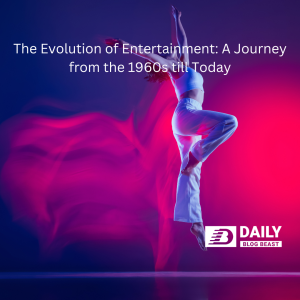Introduction
Entertainment has always been a mirror reflecting the changing values, tastes, and technologies of society. Since the 1960s, it has undergone a profound transformation, driven by advancements in technology, shifts in cultural norms, and the ever-evolving desires of consumers. This essay explores the evolution of entertainment from the 1960s to the present day, examining how various forms of entertainment have adapted and transformed over the decades.
The 1960s: A Cultural Revolution
The 1960s was a decade of profound cultural and social change. The counterculture movement, civil rights struggles, and the sexual revolution all played a pivotal role in shaping the entertainment landscape. Music, for instance, witnessed a revolution with the rise of rock ‘n’ roll and iconic artists like The Beatles and Bob Dylan. The Woodstock Festival in 1969 became a symbol of the era, showcasing the power of music as a unifying force.
Television in the 1960s was dominated by family-oriented programs such as “Admiral Andy Griffith Show” and “Leave It to Beaver.” However, it also saw the emergence of groundbreaking programs like “Star Trek,” which pushed the boundaries of science fiction storytelling.
The 1970s: The Golden Age of Cinema
The 1970s is often hailed as the golden age of cinema. Filmmakers like Francis Ford Coppola, Martin Scorsese, and Steven Spielberg redefined storytelling through movies. Classics like “The Godfather,” “Taxi Driver,” and “Jaws” not only entertained but also explored complex themes.
The music industry continued to evolve, with disco taking center stage. Iconic artists like Donna Summer and the Bee Gees ruled the charts. Additionally, the 1970s marked the rise of punk rock, exemplified by bands like the Sex Pistols and The Clash.
Television evolved with shows like “MAS*H” and “All in the Family,” addressing social and political issues. The introduction of color television brought a new level of visual appeal to viewers.
The 1980s: The Era of Pop Culture
The 1980s brought a surge in pop culture. The music scene was dominated by pop icons like Michael Jackson and Madonna. MTV, launched in 1981, revolutionized the music industry by making music videos an integral part of entertainment.
Cinema in the 1980s saw the birth of blockbuster movies like “E.T. the Extra-Terrestrial” and “Star Wars: The Empire Strikes Back.” These films used cutting-edge special effects to captivate audiences.
Television sitcoms like “The Cosby Show” and “Cheers” became cultural touchstones, reflecting the changing dynamics of American families. The era also witnessed the birth of cable TV, offering a wider range of programming choices.
The 1990s: The Digital Revolution
The 1990s marked a significant turning point with the advent of the internet and digital technology. Music transitioned from CDs to digital downloads, allowing consumers to access music instantly. The rise of hip-hop and alternative rock introduced new voices and genres.
In cinema, CGI (computer-generated imagery) transformed filmmaking, leading to movies like “Jurassic Park” and “The Matrix.” Independent films gained prominence, with directors like Quentin Tarantino making their mark.
Television evolved with the rise of reality shows like “Survivor” and “Big Brother.” The internet brought on-demand streaming and online gaming, altering how people consumed entertainment.
The 2000s: The Streaming Revolution
The 2000s saw the proliferation of streaming services like Netflix, revolutionizing how people watch movies and TV shows. This shift led to the binge-watching phenomenon, where entire seasons of shows were available at once.
Streaming services such as Spotify and Apple Music changed the way music was distributed, making it more accessible than ever. Genres like hip-hop and electronic dance music (EDM) gained immense popularity.
Cinema continued to evolve with the rise of films such as “The Dark Knight” and “The Avengers.” Several franchises emerged, including Harry Potter and Lord of the Rings, both of which were huge successes.
The 2010s: The Era of Social Media and Convergence
The use of social media platforms including Facebook, Twitter, and Instagram became integral to entertainment, allowing fans to engage directly with celebrities and content creators. YouTube gave rise to a new generation of digital influencers and content creators.
Television experienced a renaissance with shows like “Game of Thrones” and “Breaking Bad,” attracting massive global audiences. Streaming giants like Netflix, Amazon Prime, and Disney+ competed for viewers’ attention.
Music saw the dominance of streaming services, reshaping the music industry’s revenue model. Genres like hip-hop, pop, and EDM continued to dominate charts.
The Present Day: The Multiverse of Entertainment
As we step into the present day, entertainment has become more diverse and fragmented than ever. Virtual reality (VR) and augmented reality (AR) are reshaping gaming and immersive experiences. NFTs (non-fungible tokens) are changing how artists monetize their work.
Cinema faces challenges from streaming platforms, yet continues to produce blockbuster franchises like the Marvel Cinematic Universe. Television has evolved into a global phenomenon with content from various countries reaching worldwide audiences.
Music remains a dynamic force with genres constantly evolving, and artists using social media to connect directly with fans. Live concerts, although disrupted by the COVID-19 pandemic, are finding innovative ways to engage audiences through virtual performances.
Conclusion
The evolution of entertainment from the 1960s to Today is a testament to the ever-changing nature of society, technology, and culture. Each decade has brought its own unique innovations, challenges, and cultural shifts, shaping the way we consume and engage with entertainment. As we move forward, the only constant in the world of entertainment is change, and it will be fascinating to see how it continues to evolve in the years to come.


